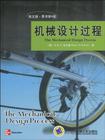机械设计过程
出版时间:2010-4 出版社:大卫 G.乌尔曼(David G.Ullman) 机械工业出版社 (2010-04出版) 作者:大卫 G.乌尔曼 页数:352
Tag标签:无
前言
机械工业出版社在2006年出版了美国大卫G·乌尔曼(David G.Ullman)所著《机械设计过程》第3版的中文翻译本,几年以后我们又见到了该书英文原版的第4版,这一版在保留原有特色的基础上有了较大的改进,反映了机械设计近年来的一些重要的发展和研究成果。本书明确提出了“产品设计”的设计原理,是针对产品设计的设计思想、理论、技术和方法的总结,而对于那些针对“机构”和“零件结构”的设计手段,只作为基础知识介绍。同时,本书全面、具体地给出了“设计学”的基本内容,详细地引出了设计的典型步骤,每一个步骤的任务和目标,应考虑的主要问题和常用的解决方法,对产品设计具有很好的指导作用。本书的主要特点是:1.针对各章节知识点给出了计算机设计用的表格,供设计者参考。2.给出了更多的设计实例和照片。3.各章前面给出了“要点问题”(Keyquestions),使读者阅读时目标更加明确。4.更新了参考资料,使本书更加实用。
内容概要
《机械设计过程(英文版·原书第4版)》明确提出了“产品设计”的设计技术,是针对产品设计的设计思想,理论.技术和方法,而对于那些针对“机构”和“零件结构”的设计技术,只作为基础知识介绍。《机械设计过程(英文版 原书第4版)》全面、具体地给出了“设计学”的基本内容,详细地引出了设计的典型步骤,每一个步骤的任务、目标,应考虑的主要问题和常用的解决方法,对产品设计具有很好的指导作用。
书籍目录
序 PREFACE CHAPTER 1 Why Study the Design Process? 1.1 Introduction 1.2 Measuring the Design Process with Product Cost, Quality, and Time to Market 1.3 The History of the Design Process 1.4 The Life of a Product 1.5 The Many Solutions for Design Problems 1.6 The Basic Actions of Problem Solving 1.7 Knowledge and Learning During Design 1.8 Design for Sustainability CHAPTER 2 Understanding Mechanical Design 2.1 Introduction 2.2 Importance of Product Function, Behavior, and Performance 2.3 Mechanical Design Languages and Abstraction 2.4 Different Types of Mechanical Design Problems 2.5 Constraints, Goals, and Design Decisions 2.6 Product Decomposition CHAPTER 3 Designers and Design Teams 3.1 Introduction 3.2 The Individual Designer: A Model of Human Information Processing 3.3 Mental Processes That Occur During Design 3.4 Characteristics of Creators 3.5 The Structure of Design Teams 3.6 Building Design Team Performance CHAPTER 4 The Design Process and Product Discovery 4.1 Introduction 4.2 Overview of the Design Process 4.3 Designing Quality into Products 4.4 Product Discovery 4.5 Choosing a Project CHAPTER 5 Planning for Design 5.1 Introduction 5.2 Types of Project Plans 5.3 Planning for Deliverables The Development of Information 5.4 Building a Plan 5.5 Design Plan Examples 5.6 Communication During the Design Process CHAPTER 6 Understanding the Problem and the Development of Engineering Specifications 6.1 Introduction 6.2 Step 1: Identify the Customers: Who Are They? 6.3 Step 2: Determine the Customers' Requirements: What Do the Customers Want? 6.4 Step 3: Determine Relative Importance of the Requirements: Who Versus What 6.5 Step 4: Identify and Evaluate the Competition: How Satisfied Are the Customers Now ? 6.6 Step 5: Generate Engineering Specifications: How Will the Customers' Requirement Be Met? 6.7 Step 6: Relate Customers' Requirements to Engineering Specifications: How to Measure What? 6.8 Step 7: Set Engineering Specification Targets and Importance: How Much Is Good Enough? 6.9 Step 8: Identify Relationships Between Engineering Specifications: How Are the Hows Dependent on Each Other? 6.10 Further Comments on QFD CHAPTER 7 Concept Generation 7.1 Introduction 7.2 Understanding the Function of Existing Devices 7.3 A Technique for Designing with Function 7.4 Basic Methods of Generating Concepts 7.5 Patents as a Source of Ideas 7.6 Using Contradictions to Generate Ideas 7.7 The Theory of Inventive Machines, TRIZ 7.8 Other Important Concerns During Concept Generation CHAPTER 8 Concept Evaluation and Selection 8.1 Introduction 8.2 Concept Evaluation Information 8.3 Feasibility Evaluations 8.4 Technology Readiness 8.5 The Decision Matrix——Pugh's Method 8.6 Product, Project, and Decision Risk 8.7 Robust Decision Making CHAPTER 9 Product Generation 9.1 Introduction 9.2 BOMs 9.3 Form Generation 9.4 Materials and Process Selection 9.5 Vendor Development 9.6 Generating a Suspension Design for the Matin 2008 Mount Vision Pro Bicycle CHAPTER 10 Product Evaluation for Performance and the Effects of Variation 10.1 Introduction 10.2 Monitoring Functional Change 10.3 The Goals of Performance Evaluation 10.4 Trade-Off Management 10.5 Accuracy, Variation, and Noise 10.6 Modeling for Performance Evaluation 10.7 Tolerance Analysis 10.8 Sensitivity Analysis 10.9 Robust Design by Analysis 10.10 Robust Design Through Testing CHAPTER 11 Product Evaluation: Design For Cost, Manufacture,Assembly, and Other Measures 11.1 Introduction 11.2 DFC——Design For Cost 11.3 DFV Design For Value 11.4 DFM——Design For Manufacture 11.5 DFA Design-For-Assembly Evaluation 11.6 DFR Design For Reliability 11.7 DFT and DFM——Design For Test and Maintenance 11.8 DFElDesign For the Environment CHAPTER 12 Wrapping Up the Design Process and Supporting the Product 12.1 Introduction 12.2 Design Documentation and Communication 12.3 Support 12.4 Engineering Changes 12.5 Design for End of Life 读者信息反馈表
章节摘录
插图:Unfortunately, often what is manufactured by a company using the over-the-wall process is not what the customer had in mind. This is because of the manyweaknesses in this product development process. First, marketing may not be ableto communicate to engineering a clear picture of what the customers want. Sincethe design engineers have no contact with the customers and limited communi-cation with marketing, there is much room for poor understanding of the designproblem. Second, design engineers do not know as much about the manufacturingprocesses as manufacturing specialists, and therefore some parts may not be ableto be manufactured as drawn or manufactured on existing equipment. Further,manufacturing experts may know less-expensive methods to produce the prod-uct. Thus, this single-direction over-the-wall approach is inefficient and costlyand may result in poor-quality products. Although many companies still use thismethod, most are realizing its weaknesses and are moving away from its use.In the late 1970s and early 1980s, the concept of simultaneous engineeringbegan to break down the walls. This philosophy emphasized the simultaneousdevelopment of the manufacturing process with the evolution of the product.Simultaneous engineering was accomplished by assigning manufacturing repre-sentatives to be members of design teams so that they could interact with thedesign engineers throughout the design process. The goal was the simultaneousdevelopment of the product and the manufacturing process.
编辑推荐
《机械设计过程(英文版·原书第4版)》由机械工业出版社出版。
图书封面
图书标签Tags
无
评论、评分、阅读与下载
用户评论 (总计18条)
- 如题,本来看了前边几页觉得跟pdf一样而且没有印刷错误很高兴,可是看完第一章结尾跟原版pdf对比之后就让我大失所望,没有了总结感觉好像整章书少了一个归宿,怎样都好像有根刺一样,少了资源链接更是让人伤心,少了这么多拓展知识的阅读(虽然不一定会看),整本书都好像断链了,后续学习困难了……少了习题(虽然不是很多人会在意这个),我真的心都碎了,叫我怎么用最快的方式来检验我的学习呢?这本书还说是原书第四版,我想应该将名字改成缩编版好了!!各位要买的童鞋得留个心眼啦!!
- 本书非常系统地讲解了从概念到产品的科学的设计过程,是对什么是机械设计的一个很好诠释。搞机械设计也6年了,期间做了很多失败的设计,总是希望能总结一些设计中通用的方法论,此书对此时的我总结经验非常有用。如果大学时能用上这样的教材,工作时应该可以少走很多弯路了。书中部分内容跟项目管理(如PMP的教材)很类似,可能机械设计就是要用科学的项目管理方法来提高效率的。
- 对于想在通过专业书籍提高专业英语水平很有帮助
- 非常好,很喜欢!非常不错
- 收到后 外观还可以 内容没来的急看
- 挺好,期待机械出版社多出版此类书籍。例如Mechanical Design等。
- 这个简单易懂,很多正好和专业相关~
- 看这本书,就像有一个老师傅在一点一滴的述说他的思考与经验
- 全英文版,但是节选的,没有想象的那好。案例很实际,但缺少参考书目。
- 还没看呢,看完再说吧
- 英语挺简单的,内容合适,以后有的看了
- 注重在概念上,看着不难,对意识提高很有帮助,比较适合工程设计管理的吧
- 没想到机工社的书的质量可以做的这么好,纸张很不错,字迹清晰,一改华章书籍的质量给我心中留下的阴影。本书讲的内容还是比较翔实,看了一些了,收获很大,里面的一些理念很值得借鉴,英语的难度不太大,读起来还是可以很流畅,一本好书,比较推荐。
- 不错的英文书籍
- 帮助你理解机械设计的过程
- 很工程化的书,眼前一亮
- 书很好,很喜欢,深入浅出
- 机械设计大范畴下的讨论
